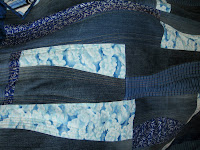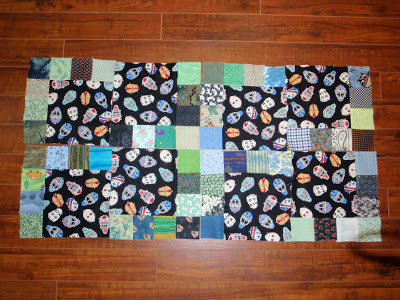This quilt design was inspired by combining
the two very traditional patterns of
"Crazy Quilting" and "Rail Fence".
It is done in a "cool" color scheme.
Custom Quilting by Lorraine Appleby.
Here is the Crazy Quilting Method for you:
Tutorial for a 9" Crazy Basket Block:
(optional math for a 10 1/2" block is at the end of the page).
Start by trimming your Crazy Blocks to 9"
Cut them in half to produce two 4 1/2" x 9" rectangles.
Gathering 4 1/2" x 9" rectangles.
Next cut sashing rectangles 2 3/4" x 9" long. You will need 2 for each of your Crazy Rectangles.
Sew the sashing rectangles to one side of the Crazy Rectangle, using a 1/4" seam.
Run your seams together to save time and thread.
Your bobbin thread will last a lot longer using this method.
Now sew the sashing rectangle to the other side, again running the seams.
Your blocks are now 9" x 9". Trim to this size if necessary.
Press to the "dark side".
Lay your blocks out like this, to create a woven look.
The bigger your quilt the more you will see the "weave".
Here it is sewn together.
The finished block sewn is 8 1/2".
Please enjoy this pattern and thank you for checking in.
This blog content is kept free for everyone via sponsorship and affiliate ads.
Please peek at the side bar for lovely quilty content.
Here is the math for a 10 1/2" block:
Cut the Crazy Rectangle 5 1/2 x 10 1/2"
Cut the Sashing 3 x 10 1/2 "
Trim to 10 1/2".
Sew to 10".
2 more tutorials for you to try...




















































